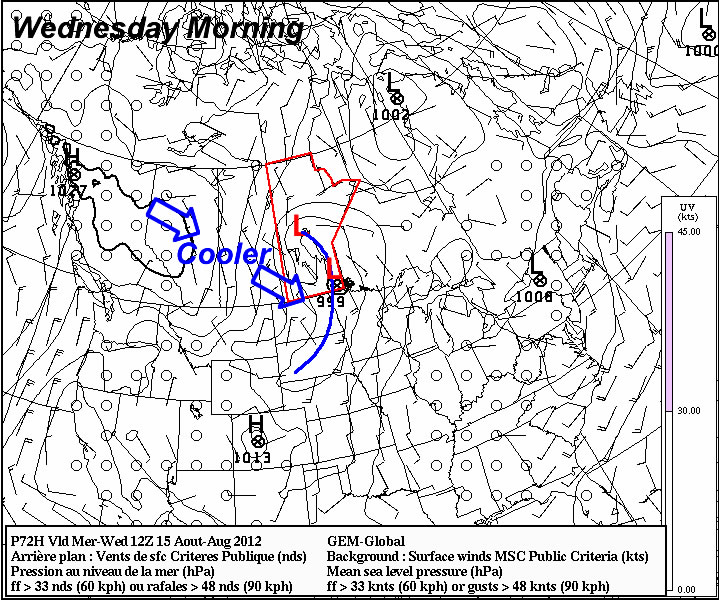A powerful low pressure system moving through the Interlake will bring significantly cooler weather to Manitoba over the next couple days. Read on to find out where the rain will be and how cool it’s going to get.
As the low pressure system passes to our north today, it will drag a cold front through the Red River Valley over the course of the afternoon. Preceding this front will be an area of rain, and while a majority of the thunderstorm activity will be through the Interlake, closer to the low, there will likely be some isolated embedded thunderstorms through the Red River Valley.
Accumulations will generally be higher the further north from the international border you go; while up to 25-50mm will likely fall through the Interlake, only 2-5mm are expected over the southern RRV. Any location in the RRV that sees a thunderstorm could easily receive between 0.5 to 1” of rain. Here in Winnipeg, we’ll probably see between 5-10mm with some locally higher amounts if a thunderstorm rolls through by the end of the day.
On the backside of this system a strong northerly wind at all levels will drag down the most potent shot of cool, Arctic air we’ve seen in quite a while. While winds will be out of the south in the morning, gusty northerly winds will kick in quickly behind the cold front, with sustained speeds between 40-50km/h and gusts as high as 60-70km/h. 850mb temperatures approaching 0°C will push down into the Interlake region tonight. This will bring with it the chance for the first significant lake-effect shower event of the “fall”1 season. When looking for the generation of lake-effect showers, there’s a few things to look for:
- A temperature difference from the surface to 850mb of at least 13°C.
- Less than 60° of wind shear between the boundary layer and 700mb; preferably less than 30°.
- At least 100km of fetch which the air travels over open water.
Given that lake temperatures are still sitting at 22-24°C, we’ll certainly see plenty of clouds develop and move south off the lakes. Whether or not lake-effect showers develop will depend precisely on the winds, but it looks fairly favourable right now with winds forecast to be from the NW with minimal directional shear. We’ll likely see some streamers develop overnight, providing showers or drizzle to communities in lee of the lakes. Current forecasts put these narrow bands of precipitation between Portage & Winnipeg and just east of Winnipeg, but we’ll have to see what the actual wind direction ends up being as to where they’ll go. Right now it looks like there won’t be enough of a westerly component to the wind to bring them into Winnipeg.
If the surface winds end up too westerly, or the 850mb temperatures don’t cool off quite as much as forecast, then no streamers will form. It will be interesting to see what happens!
In the end, it could certainly be worse than it’s going to be. The coldest air will be over us during the overnight period, and we’ll likely have cloud cover as well which will help keep things a little warmer. By the time Thursday afternoon rolls around, the cold air will already be exiting the region, so we won’t end up dealing with temperatures quite as cool as many other areas across the Prairies will.
- It’s not fall yet! ↩




